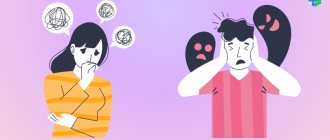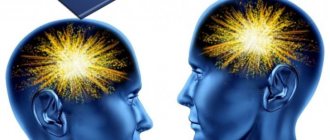In this article we will tell you:
- Obsessive thoughts as a dangerous symptom
- Causes of obsessive thoughts
- Manifestations of obsessive thoughts
- 4 methods to get rid of obsessive thoughts
Obsessive thoughts are images, dreams and fantasies concentrated somewhere in the subconscious and floating out without the person’s knowledge. It is sometimes very difficult to control them, which is why they can completely poison your life. Constant fear, anxiety and worry exhaust the body and undermine health, so such symptoms cannot be ignored.
Of course, it’s not difficult to get rid of the boring song that’s been playing in the morning from your head. It is more difficult to take control of more terrible thoughts: about an inevitable disaster, about the death of loved ones who are not really in danger, about an incurable disease, the symptoms of which were discovered by chance, and the subconscious kindly made sure that you find them in yourself. How to deal with these manifestations? There are several methods that we will talk about. But keep in mind that if your condition is concerning, it is better to consult a specialist.
Obsessive thoughts as a dangerous symptom
Obsessive thoughts, obsessions (Latin obsessio - “siege”, “embracing”) are periodically, at indefinite intervals, unwanted involuntary thoughts, ideas or ideas that arise in a person. These are difficult to get rid of and difficult to manage. A person can get stuck on them and the negative emotions they cause. Moreover, the desire to evade constant obsessive thoughts results in discomfort and anxiety. A person is constantly in anxious anticipation, and negativity comes over him. If this condition is left to chance, mental exhaustion, antisocial behavior and depression will become inevitable.
3 important steps
which every woman should go through
Anika Snagovskaya
Author and presenter of women's trainings on harmonizing feminine energy. Master of removing limiting beliefs and master of constellations.
I have prepared three lessons for you that will help you better understand yourself, remove the restrictions that prevent you from feeling loved and living happily.
01
Video lesson with meditation: 5 states of femininity
You will learn about 5 female states that exist in every woman, how they manifest themselves and which archetypes are most manifested in you and which are not developed.
02
Video lesson + meditation: How to let go of past relationships
I’ll tell you what you need to do to free your heart from old feelings and break the energy threads connecting you with your past partner.
03
Audio recording: Neuro-af
Thanks to this neuro-affirmation, you can regain self-love and feel sincere gratitude and happiness for every day.
✕
Top 3 useful materials that will help you know yourself better
And start a new, happy life for yourself.
Video lesson with meditation: 5 states of femininity
Video lesson + meditation: How to let go of past relationships
Audio recording: Neuro-af
Take your gifts!
Obsessive thoughts in the head accompany diseases such as neuroses, depression, obsessive-compulsive mental disorder and even schizophrenia.
Here is what is typical for obsessive thoughts syndrome:
- thoughts appear on their own and are beyond a person’s control;
- they represent something foreign, not connected with ordinary human reasoning;
- willpower is not able to get rid of such thoughts;
- a bad mood is accompanied by an increase in anxiety and irritability;
- the person is aware of what is happening.
This is a serious condition. The person subject to it observes his obsessive thoughts; he understands how groundless they are, but cannot overcome them. Realizing this causes a person even more suffering.
What are obsessive thoughts and what is their nature?
- Represent words, phrases or verses.
- They have a variety of content.
- They are perceived as their own thoughts.
- Can be seen as critical thinking.
- The desire to get rid of them leads to anxiety and tension, and mental imbalance.
- If they are present, the function of transferring attention is turned off and there is no ability to get distracted.
- Affect behavior.
- Most often they carry a negative connotation.
People with such symptoms agree that the reasoning repeated over and over again is groundless, but this does not help to eliminate them. In order not to go crazy from obsessive thoughts, to avoid the intensification of this condition and the emergence of complications, you should see a specialist (psychotherapist or psychiatrist).
Variants of confusion
Human consciousness is a matter that remains a mystery. No doctor can say for sure why one patient with VSD develops derealization and another does not.
Most scientists agree on the innate abilities of the nervous system to resist stress and other negative influences.
In addition to derealization, there are degrees of confusion that are characteristic of patients with VSD:
- Drowsiness.
- Brief loss of consciousness without visible symptoms. A person “disconnects” from reality for seconds, but maintains balance. People around you may not even notice it. In some cases, we are talking about a special type of stupefaction (epileptic “twilight”), for example, with absence seizures and ambulatory automatisms.
- Stun. The patient demonstrates decreased motor activity. Drowsiness progresses. Patients describe the sensation as confusing, as if “in a fog.” Derealization progresses.
Against the background of autonomic dysfunction of cerebral vessels and stress, a person may well faint. To prevent the consequences of derealization, therapy must be started on time.
Causes of obsessive thoughts
The appearance of obsessive thoughts and states is preceded by various factors, and they are specific to each person. So their diversity can be reduced to the most common:
- situations causing various types of trauma: death of a loved one, accident, violence, etc.
- a state of stress caused by events at home, at work or even in society;
- minor or significant memories of childhood, as well as the recent past, with a negative connotation;
- a feeling of inconsistency with expectations from society or the inability to fit into it and, as a result, high or low self-esteem;
- unconscious behavior that forms a variety of mental illnesses and, thus, leading to self-destruction;
- a combination of circumstances in which it is difficult to make a fateful decision;
- denial of objective reality and recognition of oneself as the center of the universe creates the preconditions for an inadequate perception of the surrounding world;
- the appearance of a state of anxiety at moments when a person begins to evaluate himself from the point of view of others and becomes dependent on the opinions of friends, colleagues, family or random people.
Psychocorrection of obsessions
Manifestation of feelings of fear in dystonia
The development of medicine has made it possible to achieve good results; today, even the most advanced cases have a favorable prognosis, provided that specialists work competently. To reduce anxiety, the following methods are used:
- working through the root causes of stressful situations - discussing with the patient what will actually happen if a person exposes himself to his fear (stops washing his hands a hundred times a day or does not spit over his shoulder three times while crossing an intersection);
- decreased sensitivity to provoking factors - this component of treatment involves the use of hypnotic influence on a person;
- providing a person with tools to independently reduce feelings of anxiety and deal with their problems in everyday situations.
Manifestations of obsessive thoughts
You can analyze the behavior provoked by obsessive thoughts yourself using the following symptoms:
- a constant state of anxiety, the emergence of fears and self-doubt;
- having tedious conversations with yourself;
- constant doubt about the correctness of my actions (did I turn off the iron or gas before leaving, will I be able to defend my position, etc.);
- a strong desire to do something unacceptable and having symptoms of fear: splash water in the interlocutor’s face, swear, and so on;
- fear of causing physical harm to yourself and others;
- overthinking oneself because of a feeling of shame for the act committed and self-flagellation about this;
- sexual fantasies that are far from real fulfillment;
- unreasonable fear of death in a child;
- painful preoccupation with one's appearance in a teenager;
- fear of contracting a fatal disease and much more.
When obsessive thoughts overwhelm a person and interfere with his life, he experiences physical tension in the body. This may manifest itself in:
- increased heart rate;
- shortness of breath and dizziness;
- nausea and polyuria;
- fainting;
- increased sweating and other symptoms.
Who is susceptible to OCD?
Most often, OCD affects sensitive people who are not inclined to show aggression, who have an internal conflict between “what I want and what I don’t want.” It is the basis for the emergence of neurosis. The disorder appears between the ages of 10 and 30.
Healthy people can perform rituals, but if they do them for more than one hour a day, and non-compliance with them causes great discomfort, we may be talking about making a diagnosis.
A large number of popular movie stars suffer from one form or another of OCD, spending part of their lives in anxiety due to unfulfilled rules and rituals. The famous Leonardo DiCaprio played the main character with OCD disorder in the film “The Aviator,” and the actor himself used to walk through doorways a certain number of times and avoid stepping on cracks in the asphalt.
Footballer David Beckham suffers from OCD, he likes everything to be symmetrical and systematized.
Actress Charlize Theron cannot sleep if her closet is not in perfect order, and if everything is in place, then she is disturbed by thoughts of the disorder of her friends.
As a result of treatment, many manage to reduce their anxiety levels and get rid of rituals. You shouldn’t be ashamed of your condition and isolate yourself within walls, trying to hide it from everyone.
Benefits of treatment for repetitive thoughts in our clinic
- We accept by appointment
. We set a convenient date and accept you at the agreed time without delays or waiting in line. - We make an appointment online or by phone
. To make an appointment, you do not need to visit our clinic in person, just call or write on the website. - We prescribe comprehensive treatment
. We combine psychotherapy, medications, and relaxation procedures for maximum effect. - Support after treatment
. We leave the contact details of the attending physician, whom you can contact after the course of treatment for advice and support.
Call us to make an appointment with a psychotherapist. You can ask questions to the doctor and find out the cost of treatment using the contact form on the website, we will respond within a day.











